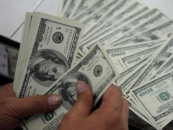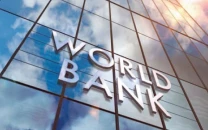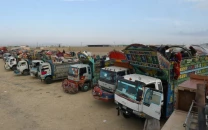The changing landscape and face of Pakistan’s auto sector
Govt has taken various measure to promote the industry including announcing the auto policy in 2016

A car manufacturering plant.
PHOTO: REUTERS
The PML-N can take heed from the Automotive Policy 2016-21 that has resulted in several carmakers pushing for an entry in the country’s growing market.
Korean players including Kia, Hyundai and SsangYong Motor Company, Germany’s Volkswagen, French carmaker Renault and Japan’s Nissan have all announced that they would assemble vehicles in the country. This has finally resulted in a challenge for the current players that have long operated in the over $300-billion economy alone.
Apparently, the government would achieve its long-standing goal of breaking the auto cartel, improving quality of locally-assembled cars and bringing down car prices through increased competition.
It has also helped the government that oil prices plunged during its tenure, cutting inflation rates to manageable levels and bringing down interest rates that would make car financing a lot more affordable.
The low interest rates at around 6% have also been attributed to have helped increase car sales through car financing.
According to research analyst Raza Jafri of Inter-market Securities, the government’s dilemma regarding Pakistan’s auto sector is to establish which is the lesser of the two evils.
The first one is to curtail shipments into the country to save foreign exchange reserves, which would mean restricting imports, but also restricting consumer choice and benefitting the auto sector.
The government could alternatively adopt a liberal import policy, enhance competition, but also then risk depletion in foreign exchange reserves at a faster pace.
Analysts feel the government has looked to curtail imports in the wake of low foreign exchange reserves, thereby incentivising the auto sector in the country.
Budget proposals
The All Pakistan Motor Dealer Association (APMDA) wants the government to allow import of used cars without age restriction. It has also requested the government to reduce tax and duties in order to curb smuggling.
It is, however, a general impression that the government is unlikely to pay heed to the requests.
Shahzad, on the other hand, says reducing tax and duty rates, while removing the age restriction, would not reduce government revenue but actually increase it.
The import of used cars has seen a massive jump in recent years. In large part, the increase is due to lack of choice in the local market, quality issues within the sector, and capacity constraints the industry faces.
A total of 79,000 imported used cars were sold in 2017 – a huge jump from 55,000 cars in 2016.
Potential remains
Pakistan’s low motorisation rate of 17 per 1,000 shows that there is great potential in the market provided per capita income increases in the country. India, a country of 1.32 billion, has a motorisation rate of 22. Japan and some European countries have a motorisation rate of 600.
Pakistan’s per capita income stands at $1,629, according to the Pakistan Bureau of Statistics. The Planning Commission says Pakistan’s per capita income could reach up to $4,200 by 2025, with the country’s economy getting a big boost from the China-Pakistan Economic Corridor.
If growth remains the way it has been, Pakistan could see a lot more cars on its roads.



















COMMENTS
Comments are moderated and generally will be posted if they are on-topic and not abusive.
For more information, please see our Comments FAQ